Most members of the Lynah Faithful know that Cornell met Harvard in 1910 for the first time. Clashes between the Red and Crimson began to have elements of the spectacle that they are today in 1962. That rivalry struck a fever pitch in the 1972-73 season as fowl and fish found their way to the ice surface. Cornell's rivalry with Wisconsin began in 1970 when the Big Red eliminated the Badgers after they had received their first berth to the NCAA Tournament. The 1973 and 2006 installments of that series solidified the tone of the Cornell-Wisconsin series. As Red Hot Hockey IV looms on the horizon, this writer realized that few know the stories behind the first encounters of the two historic rivals of Eastern college hockey. These are those stories.
East Hill, nestled in Central New York, and not far from Ontario, proved fertile soil for the emergence of a great college hockey program. The Cornell Daily Sun reported that students as early as the 1890s had palpable interest in starting a hockey program for the University. It took several years and several near misses before Cornell finally began sponsorship of a collegiate hockey program for the 1900-01 season. Coach Smith led his icers to a perfect season over three contests. Cornell outscored its opponents three to one.
The banks of the Charles River waited nearly two decades more before Boston University began sponsoring a collegiate hockey program. Boston University began its first college hockey season with Coach Burkhardt leading the skaters of the University. The team that had not gained a mascot yet fell in its single contest of the season. The contest was played at the Boston Arena of the early 19th Century. The paths of the eventual rivals were set to collide.
Between the first contest that Cornell hockey played to its first meeting with Boston University, 25 years passed. Boston University waited a mere eight years to confront its historic New York-hosted foe. The series opener occurred in Boston University's fifth season. Boston University appeared on Cornell's schedule for the first time in the Big Red's 19th season.
Boston University and Cornell, two programs that would become synonymous with greatness in college hockey, experienced only mere punctuated success before the 1924-25 season. Cornell owned an all-time record of 40-42-3 before that season. Boston University fared worse with an all-time record of 3-17-0. Six and three coaches had led the programs of Cornell and Boston University respectively. Despite these obvious setbacks, Cornell compiled four perfect seasons including an undefeated and untied season for a national title in 1911.
Boston University and Cornell arranged to square off on the ice on January 10, 1925. It would be the first time that the two programs met in a semi-continuous series that is now nearly 90-years old. Legendary coach Nicky Bawlf led the Central New Yorkers against the Bostonians. It was Bawlf's fifth season for Cornell. His opponent on the other side of the ice would be George Gaw who was leading Boston University's icers in his first season.
Boston University's hockey program took only its second trip outside of New England when it swung through Clinton, NY and Ithaca, NY. Boston University possessed a 1-1-1 record before its road trip. The lone win was against Boston College. The meeting with Boston University was Cornell's first contest of the 1924-25 season.
Boston University had practiced for over a month on the artificial ice service at Boston Arena. Cornell relied upon the natural ice of Beebe Lake to practice. The weather on East Hill was not conducive to the Bawlfmen's practices. Cornell had been unable to get on the ice until the Monday before its game against Boston University. The roster of its team was not expected to be finalized until the afternoon after the game against Boston University.
The 1924-25 team for Cornell University returned only three players. Stainton led the team as captain while the other two veterans were Tilton and White. The other members of the team included former members of the freshman squads at Cornell. Benton, Boesche, Bubier, and Cook counted themselves among those ranks. Newcomers who were expected to become star forwards for Cornell were Aronson, Breckenridge, and Wright. Coach Bawlf was greeted with 50 potential players who wanted to represent the young university in Ithaca. He would retain most of them.
Boston University had made its potential known early in the 1924-25 season. Coach Bawlf was keenly aware of the quality of his first opponent in his fifth season. Bawlf highlighted two players in particular that had propelled Boston University to a 0.500 winning percentage before the weekend's contest. M. Kontoff and Martin were those players. The former served as a defenseman and captain. The latter was Boston University's goaltender, or as he was dubbed then "goal guard." Boston University had not recorded a winning season before the 1924-25 season, but most in the small community that was college hockey began to believe that was about to change.
Cornell's line-up for the first installment of what would become Red Hot Hockey included three veteran players and three sophomores. The Red skaters that would take the ice against the Terriers, a nickname that Boston University adopted a few years prior in 1922, were Bubier, Cook, and Tilton as forwards, Edminster and White as defensemen, and Stainton as the goaltender. Gaw of Boston University would put up Lawless, Scott, and J. Kontoff as forwards, M. Kontoff and Ling as defensemen, and Martin as the goaltender to respond to Bawlf's unknown talents. Nicky Bawlf, in a manner that predicted the eventual arc of Cornell hockey strategy, stated that Cornell's playing of a sound defensive game would allow his team a chance to defeat the Terriers.
Face-off was announced in The Cornell Daily Sun with much fanfare and emphasis. Cornell hosted Boston University at Beebe Lake at 3:00 pm on Saturday, January 10, 1925. Gaw's team was reeling from the previous night's 2-0 loss to Hamilton College. Boston University was motivated. Cornell was untested.
The action that throngs of Cornell students witnessed on Beebe Lake unfolded in the shadow of the yet unbuilt Balch Hall. Fans stood on the ice against the make-shift boards that rose a few inches reinforced with mounds of snow to hold them in place. The skaters of both universities dazzled the fans with their speed. Boston University penetrated Cornell's zone immediately after the opening face-off. As Bawlf predicted, sound netminding and defensive play allowed Cornell to return the rush.
Cook, for the Big Red, collected the puck in his end and maneuvered it between Boston University's captain and Ling. The Cornell forward split the defenders and had an open shot on Boston University's exposed netminder, Martin. Cook unleashed a shot and it found the back of the net at one end of the Beebe Lake rink. Cornell students who knew or had heard of previous eras of hockey greatness at Cornell applauded. It was a sophomore forward from Cornell who scored the first goal of the now-historic Boston University-Cornell series.
In an era when line changes had not become a part of the game, Nicky Bawlf found himself needing to make many substitutions to keep his less conditioned skaters fresh against the better conditioned Boston University squad. Bawlf would make 14 substitutions during the course of the game. Gaw would make only four such changes.
Cornell controlled the first third of the game. Boston University had difficulty generating considerable offense and the Big Red kept pace with the Terriers at the early stages. The game remained essentially even with Cornell's enjoyment of any slight advantage. The game changed abruptly.
Boston University took over. The Terriers would total seven goals after Cornell opened scoring in the contest and series. Boston University's Lawless and Scott bested Stainton in Cornell's net twice each. Both M. Kontoff and J. Kontoff added a goal. Ling would score a lone goal as well. The Big Red was unable to equal such an offensive outburst, but it was not entirely answerless.
One of the substitutions that Nicky Bawlf made paid dividends. Aronson was the first player to be substituted into the contest for Cornell. He was also the last. It was on Cornell's last substitution of the game that the sophomore skater impressed. Spectators witnessed the speed and agility of the smaller Aronson as he produced multiple chances in Boston University's end of Beebe Lake. The second goal for Cornell came from Aronson's swiftness. The sophomore provided a meek response, despite the spectacle of its form, to Boston University's seven-goal run.
Cornell fell 7-2 to Boston University on Beebe Lake in the first meeting between the programs. Cornell went on to lose three more contests that season while recording only one win. The opposite was true for Boston University. A successful program finally represented Boston University. The Terriers went on to earn a 7-4-1 record. It was the first winning season in the history of Boston University hockey.
The second meeting between Cornell and Boston University occurred just over a year later on January 23, 1926. After its first successful season, many in college hockey believed that Boston University would compete for a national title in the 1925-26 season. Dartmouth was expected to be Boston University's main competitor for a national title. Cornell, 14 years removed from its own national title run, had far more modest expectations before the 1925-26 season.
The Boston University-Cornell game in 1926 was not Cornell's first of the season. Cornell hosted and defeated Clarkson in a 2-1 affair. The Big Red traveled to play the Big Green of Dartmouth at Davis Rink earlier in January. The hopeful national champions in Hanover embarrassed Nicky Bawlf's skaters with a 12-1 victory for the home crowd. It was one week before Cornell would confront the Terriers, the other anticipated competitor for the national title, at Beebe Lake. The outlook seemed bleak.
The importance of the Boston University-Cornell contest became evident. Boston University could not risk a loss that could prove fatal to their national title hopes. Cornell wanted to make a statement on its lake after the Terriers inflicted the biggest loss that Cornell hockey had suffered in Ithaca in its quarter-century history.
Bawlf's preparation for the game indicated the weight that he gave the contest. A collection of graduated college hockey players who were regarded as all stars scrimmaged against Cornell just days before the tilt between Boston University and Cornell. That team included star players from programs such as Princeton.
The beginning of the second meeting between the Big Red and Terriers could not have been more unlike the end of the first contest. Cornell's captain, Tilton, a senior forward, collaborated with junior forward, Aronson, to keep consistent pressure in Boston University's zone for much of the first half of the contest. For much of the contest, it appeared as though it was Aronson and Tilton against Martin, Boston University's goaltender. The two Cornell forwards bested Boston University's defensemen with surprising ease, however the Terriers's netminder was more than equal to each challenge through almost the entirety of the game.
Cornell's defenseman Taylor and its netminder Nash had answers for the few challenges that the Terriers could muster. The game was Cornell's for the taking. The wool-clad spectators who watched on the Lake as Cornell battled Boston University must have imagined there was a 50-50 chance as to which Cornell skater would best Boston University's Martin for a victory. They were partially right.
The minutes of the game lingered. They passed nonetheless. Boston University could not solve Nash. Cornell could not solve Martin. Gaw managed to change the flow of the game in the second period. The head coach of the Beantown natives substituted Gregoire for Scott. The Terriers were energized immediately. The pace of the game hastened. Cornell continued to generate chances, but Boston University had clawed its way back into the game.
The third period arrived with neither team scoring. The game was back-and-forth. Cornell generated sustained pressure down low. A scramble of bodies and sticks in front of Boston University's cage and Martin resulted. The speedy Aronson was predictably part of the offensive effort. It was Aronson who blasted the puck into the back of the Terriers's net. Cornell had broken the deadlock. It had battled even with a bona fide national title contender and it had taken the lead.
A series scarcely can be a rivalry without its contentions and controversies.
The moment that Aronson deposited the puck into Boston University's net, the Terrier skaters and Coach Gaw protested and gesticulated wildly. Bawlf and his Cornell skaters believed it to be a good goal. The Boston University partisans demanded that the goal be disallowed. They claimed that Cornell's rush on Boston University's net was a result of an off-side pass. Cornell disagreed. Vehemently. The officials sided with Boston University in the most controversial call in Cornell hockey history at that point.
The game returned to a 0-0 mark. Aronson had scored with less than four minutes remaining in the contest. His efforts were for naught. Less than one minute after the contentious debate about Cornell's would-have-been goal, Boston University found an answer to Cornell's Nash.
Boston University's Gregoire collected the puck from behind the Terriers's net after Cornell apparently had found the back of it. He raced from his end of Beebe Lake toward the Cornell zone. As he reached the blue line along the boards, he unleashed a shot at Cornell's net. The puck off of his stick took an odd path, arced, and fell into Cornell's net. Approximately three minutes remained in the contest. Boston University took a one-goal lead. The goal, unlike that of Cornell, stood.
Time expired. Boston University won the contest. Boston University earned the first two victories in the series. Cornell felt that it had earned a split and was denied a marker that would have guaranteed the Big Red at least a tie against Boston University. Cornell would not soon forget the anger at a possibly deciding disallowed goal. This controversy made the animosity of the rivalry even more pitched. It was evident as the assemblage on Beebe Lake departed that the programs of Boston University and Cornell were destined to become heated and historic foes.
More than four decades would pass between the first two meetings of Boston University and Cornell, and the beginning of the modern series. Cornell may have fallen in the first two encounters on Beebe Lake, but it would go undefeated in the next 11 meetings with ten victories over that span. It is hard to believe that deep in the recesses of the institutional memories of Boston University and Cornell hockey that the controversy of that January 1926 game was not the germ of a heightened rivalry that biennially fills Madison Square Garden in college hockey's greatest single-game event.
The rivalry is a historic one, not just because nearly one-tenth of the installments of the series have decided championships, but because of its sustained passion. The first time that Boston University and Cornell faced off, three of the Original Six of the NHL had not been established. One of the three that had, the Boston Bruins, was not even two months old when the Big Red and the Terriers first battled on Beebe Lake. The series is an essential element of hockey culture in the United States.
When the Lynah Faithful and Terrier fans assemble at the newly renovated Madison Square Garden this November, it is easy for them to forget the humble origins of the series they are about to witness. They are the descendants of spectators huddled along mounds of snow on a frozen lake in Central New York to witness the rivalry's first installments. It began like the sport itself, on a natural frozen pond. It is appropriate to know the history of the rivalry in the 1960s and 1970s. It is important to reflect that a rivalry immortalized during its eras with Harkness and Kelley at Lynah Rink, Walter Brown Arena, and Boston Garden began with Bawlf and Gaw on Beebe Lake. The rivalry may grow and change, but it was a rivalry from the first.

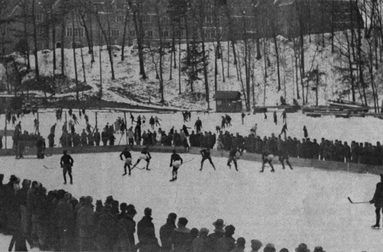
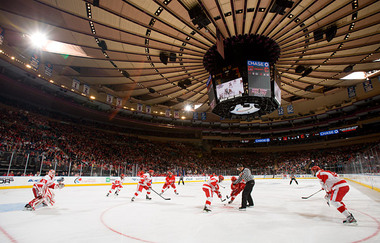



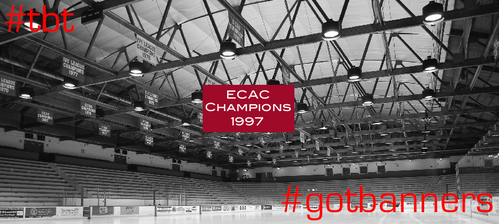
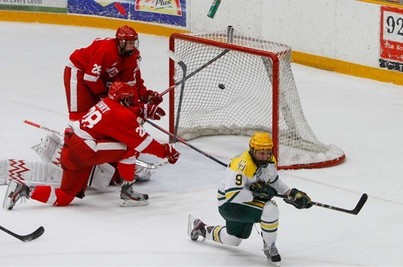


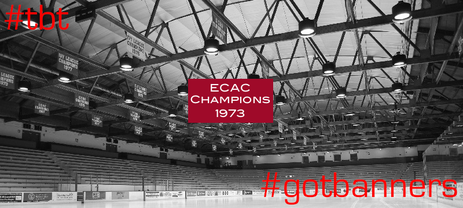


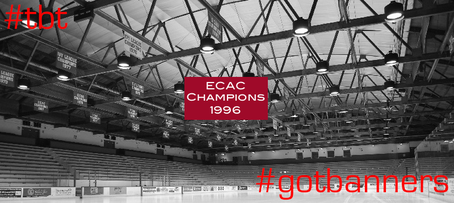
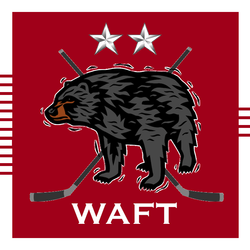

 RSS Feed
RSS Feed
